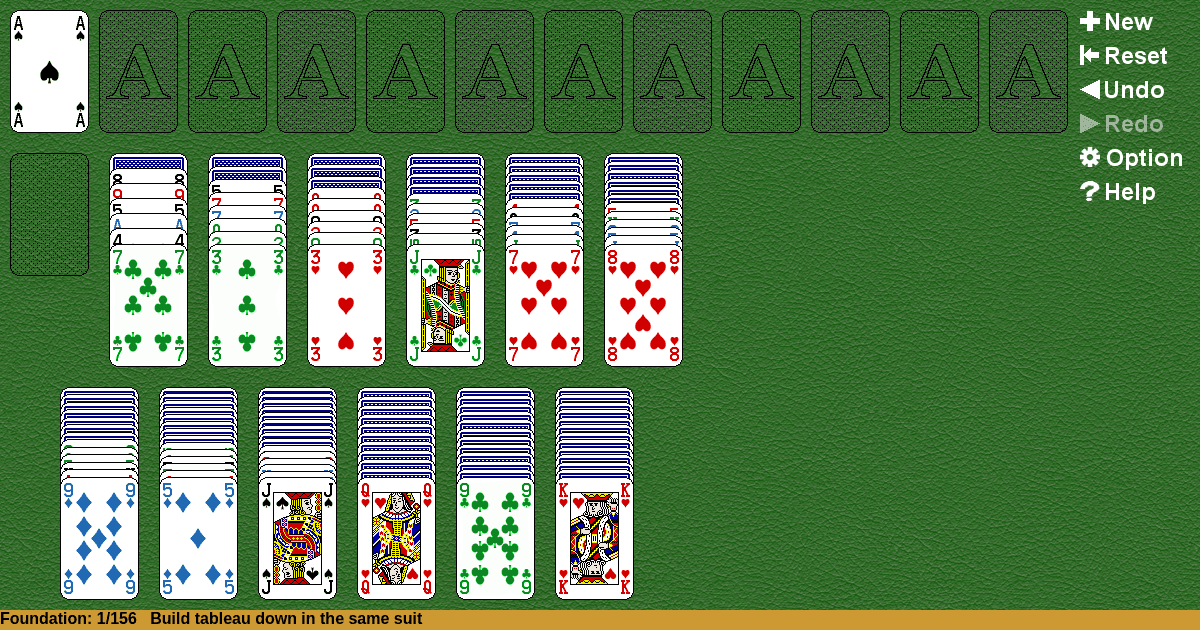Triple Russian
Home |
How to play |
FAQ |
About
How to play Triple Russian?
Game Objective:
The primary goal in Triple Russian Solitaire is to move all cards from the tableau to the twelve foundation piles, building each foundation up from Ace to King by suit.
Setup & Layout:
- Deck: Triple Russian Solitaire uses three standard 52-card decks (totaling 156 cards).
- Tableau: The tableau consists of 13 columns. Cards are dealt as follows:
- The first column receives one face-up card.
- Each subsequent column receives one more card than the previous, with the top card face-up and all others face-down.
- This pattern continues until all cards are distributed, resulting in 13 tableau piles of increasing length, each with the top card face-up and the rest face-down.
- Foundations: There are 12 foundation piles (three for each suit: Hearts, Clubs, Spades, Diamonds). All foundation piles start empty.
- Stock/Reserve: There is no stock or reserve pile in Triple Russian Solitaire.
Key Play Areas:
- Tableau: The main area where cards are arranged and manipulated.
- Foundations: The area where cards are built up by suit from Ace to King.
Triple Russian Solitaire Rules:
- Building Sequences:
- Tableau: Cards are built down by the same suit (e.g., 7♠ on 8♠).
- Foundations: Cards are built up by the same suit, starting with Ace and ending with King (e.g., 2♦ on Ace♦, then 3♦, etc.).
- Moving Cards:
- Any card or group of cards can be moved within the tableau, regardless of the internal sequence of the group, provided the bottom card of the group follows the tableau’s building rule (i.e., it is one rank lower and of the same suit as the card it is placed on).
- Only one card at a time may be moved from the tableau to the foundation.
- Empty Spaces:
- Only a King or a group of cards headed by a King may be moved into an empty tableau column.
Gameplay:
- Typical Turn Sequence:
- Move any available face-up card or valid group of cards within the tableau, following the building down by suit rule.
- Move eligible cards to the foundations, building up by suit from Ace to King.
- When a face-down card is exposed in the tableau, immediately turn it face-up.
- Fill empty tableau spaces only with Kings or groups headed by a King.
- Introducing New Cards:
- No new cards are introduced during play; all cards are dealt at the start.
- No Moves Available:
- If no legal moves remain, the game ends and is considered lost.
Winning & Losing Conditions:
- Winning Condition: The game is won when all 156 cards have been moved to the twelve foundation piles, each built up by suit from Ace to King.
- Losing Condition: The game is lost when no further legal moves are possible, and not all cards have been placed in the foundations.
Special Rules & Edge Cases:
- Filling Empty Tableau Columns:
- Only Kings or groups of cards headed by a King may fill empty tableau spaces.
- Moving Groups:
- Groups of cards can be moved together within the tableau, regardless of their internal sequence. The only requirement is that the bottom card of the group must be one rank lower and of the same suit as the card it is placed on.
- Turning Cards Face-Up:
- Whenever a face-down card is exposed in the tableau, it must be turned face-up immediately.
- No Stock or Reserve:
- There is no stock or reserve pile; all gameplay occurs within the tableau and foundations.
- Foundation Recycling:
- Once a card is placed on the foundation, only the top card may be moved back to the tableau if needed to build sequences.
- Strategic Considerations:
- Players should prioritize moves that expose face-down cards and balance moving cards to foundations with maintaining flexibility in the tableau.
Definitions:
- Tableau: The primary play area consisting of 13 columns where cards are arranged and manipulated.
- Foundation: The area where cards are built up by suit from Ace to King; the ultimate destination for all cards.
- Face-Up/Face-Down: Cards dealt face-up are visible and playable; face-down cards must be exposed before use.
- Group Move: Moving a set of cards together, regardless of their internal order, as long as the bottom card fits the tableau’s sequencing rule.
This guide provides a precise and authoritative reference for playing Triple Russian Solitaire according to the variant’s unique ruleset.

Solitaire Collection
About Triple Russian
Rate (Triple Russian)
4.7 / 5
1,916 votes



























































